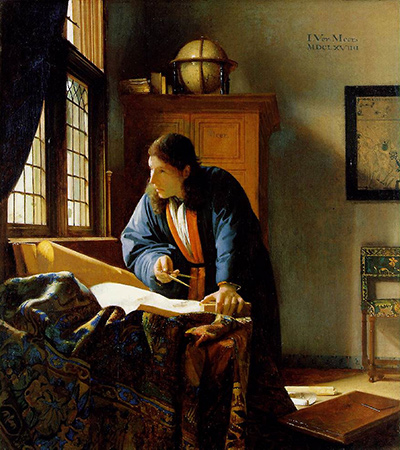Vermeer's The Geographer is a study in intensity. It features a young scientist who seems to be on the cusp of something great. He has found the solution to a problem and that moment of illumination is caught perfectly in Vermeer's art.
The intensity of the problem solver contrasts greatly with the small but important signs around him which indicate just how much that intensity costs. Yet, these small symbols fade into insignificance.
They are not the focus of Vermeer's compositions. The viewer is invited to appreciate the thought process, invited to look ahead to new things that will result because of what The Geographer has just discovered.
The impact of the sciences expanded significantly in the seventeenth century, especially in Holland. This situation is reflected in the way that researchers were much sought after as pictorial themes. The Geographer is a case of that. Johannes Vermeer was well known for his smaller paintings, some of which focused on the sciences.
Originally from Delft, Vermeer is now known around the world. He painted a geographer in his own space, giving us an intimate view of the scientist's thought process. He is twisted around his working table and encompassed by the utensils of his education. He is distant from everyone else in reasoning and does not give off an impression of expecting guests. His work takes priority for him and there are papers lying on the floor.
His housecoat is another indication of his withdrawal into the domain of his work. An all-inescapable quietude is portrayed in the scene. He is caught at an instant in time that will never be seen again and his hand is poised in mid-air, emphasising that something momentous is happening.
The paintings show the viewer that the main action is happening behind The Geographer's temples. He is truly washed in the light of acknowledgment. Vermeer has concentrated the whole environment in this one spot. As yet hanging over his papers, compass close by, the geographer lifts his gaze towards the light flooding in through the window. It is as though the ideal answer for his issue has quite recently occurred to him.
This ability to capture such intensity is what has helped to make Johannes Vermeer one of the best known specialists of Holland's Golden Age. His refined painting method explores different avenues regarding optics and point of view. He developed his own special technique for passing on light in his work. The graceful character of his pictures stay fantastic in their inventiveness and the force of their effect on the person looking at them.
Vermeer painted The Geographer in 1669. It is a genuinely tiny bureau picture that the craftsman marked twice. Contrasted with the other works displayed by him, it mirrors an alternate part of Vermeer's collection of interesting topics. The young fellow's casual posture, brimming with a feeling of quickness, and his tricky look that is not settled on a particular question show the transience of the circumstance.
The fine play of light reflexes on the finished surface of the material combined with the gleaming white spread of paper on the work area bring life to the painting. Delicate shadow on the divider and accents on the Geographer's apparel have been painted with extraordinary delicacy and meet up to make a painting of uncommon congruity. There is something supernatural about this scene without plain activity. A dramatic impression appears to have been grabbed from the stream of life in a route reminiscent of a still from a film.
The land guide and globe gave grounds to distinguishing the personage in the artwork as a geographer. From 1713 straight up to the finish of the eighteenth century, in each exhibition The Geographer was displayed with another related work by Vermeer. That piece may have been completed as a companion piece and was known as The Astronomer.
In making The Geographer and The Astronomer, the craftsman painted the picture of a researcher occupied with science. His work also had a more extensive philosophical angle. The globe is an image of the universe and was a popular theme in seventeenth century artistic creations. An earthbound or divine globe was included in many pictures, in class scenes and in Dutch still lifes. It assumes an essential part in the work of Rembrandt and his followers.




